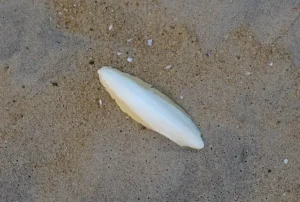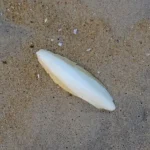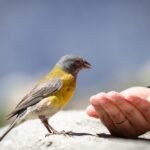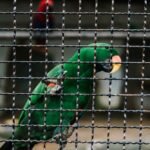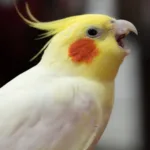Parrots have exceptional vocal abilities, but they also like to communicate through their body language. Eye pinning is one of the many body language signs parrots use to convey their emotions.
Eye pinning is a distinctive behavior in parrots, where their pupils rapidly constrict and dilate. When your parrot’s eyes are pinning, you may see their pupils turn bigger and then quickly contract to a black dot.
Usually, when a parrot’s eye pins, it means they’re excited. However, it can have different meanings depending on other behavioral cues the parrot exhibits.
For example, when a parrot is engaged with an object, their pupils tend to constrict, showing their keen attention. Conversely, when the parrot loses interest, their pupils may dilate.
Quick Navigation
What Is Eye Pinning?
Eye pinning is a common trait among all parrot species. It is sometimes also referred to as eye flashing or eye blazing. During eye pinning the pupil in a bird’s eyes contrict and dilate rapidly.
In humans, the constriction and dilation of the eyes is often a result of the amount of light they receive. When it is dark in a room, the pupils enlarge or dilate, which enables the eyes to let more light inside. Similarly, when it’s bright, pupils constrict or get smaller.
However, unlike humans, the movement of the parrot’s pupils seems to be affected by other stimuli, independent of the light coming to the eye. Parrots can pin their eyes to communicate with their owners or flock members. It can signal excitement, anger, fear, or curiosity.
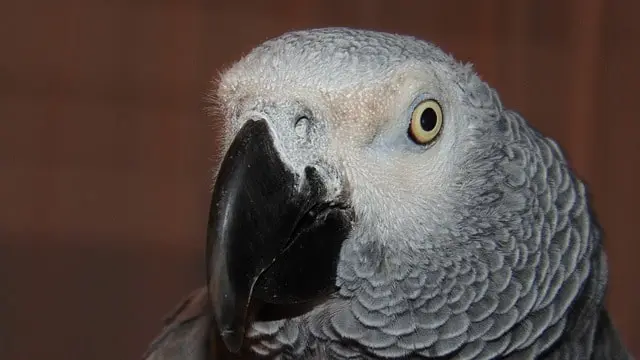
Why Do Parrots Eyes Dilate?
There can be many reasons a parrot’s eyes dilate in and out. In order to understand the meaning behind this behavior, you will have to look at the accompanying body language signs your parrot exhibits.
Excitement
More often, when a parrot’s eyes are pinning, it is to express their immense excitement and happiness. This excitement can be in anticipation of a treat, playtime, and getting out of their cage.
You may also notice your parrot’s eyes get bigger when they’re talking. This shows that the parrot is excited. Their eyes dilate for a brief moment which suggests that the parrot is engaged in conversation.
A study published in the Nature Journal observed strong pupillary constrictions in an awake yellow-crowned Amazon parrot when it was hearing or speaking its favorite words.
Sometimes, eye-pinning can also be an expression of love. Your parrot wants to tell you that it likes and adores you.
Aggression
Parrots also pin their eyes when they perceive a threat near them. Parrots can be territorial and when they feel like someone is encroaching on their space, they may get defensive. Eye pinning can be a way for them to show aggression and ward off threats.
According to AFA Watchbird, a parrot exhibiting an aggressive strut and eye pining can suggest that it does not want anyone trespassing on its territory.
Usually when a parrot is being aggressive, it will assume a hunched-down posture and stare at the threat. It may also fluff its feathers and make aggressive vocalizations like hissing, squawking, and growling.
Aggressive body language signs:
- Flapping wings
- Puffing up feathers
- Hissing
- Screaming
- Feathers sticking to the body

Curiosity
It is part of a parrot’s exploratory nature to be curious and probe things in its surroundings. It allows the parrot to get familiar with their environment.
When a parrot is staring at something intently, it means that it is highly engaged in its surroundings. You may have seen your parrot staring closely at a particular object and dilating its pupils.
Research from the University of Wisconsin-Whitewater suggests that a parrot’s pupil constricts when viewing objects of high interest or familiarity.
The study conducted looked at how a parrot’s pupils change in response to different objects of varying degrees of familiarity and interest.
Researchers recorded the reactions of the parrot’s pupils while it was exposed to different objects. Additionally, they examined how the size of its pupils related to two particular behaviors: when it fluffed its feathers and when it reached out to touch the objects. This helped in understanding how the parrot’s level of interest affected the size of its pupils.
It was found that when parrots encountered something new in their environment, their pupils constricted.
However, when the parrot was exposed to the same object for a longer duration, around 20 minutes, its pupils dilated, but their behavior indicated boredom and fatigue.
Also, when a parrot got more used to the objects over time, its pupils became smaller but returned to their normal size shortly after.
Courtship Behavior
Male parrots exhibit numerous courtship behaviors to attract female parrots, including eye pinning. Pupil flexion is a notable courtship display often accompanied by other signs like extending the head, spreading wings, and head waving.
These behaviors are key components of their courtship ritual and help to attract the attention of potential mates.
According to a research study published in The Condor, Volume 65, Issue 3, parrots constrict their pupils when they are aroused, such as during courtship. This gesture is often followed by a deep bow towards the female parrot.
As the courting bird approaches the female parrot, it constricts its pupils while feeding it with its beak. However, the pupillary behavior is not present during copulation or when the bird is not aroused.

